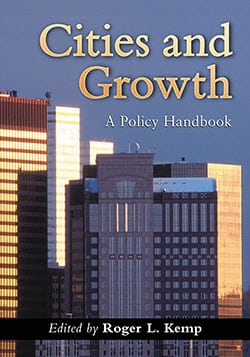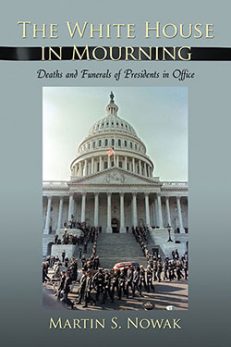Subtotal: $39.95
Cities and Growth
A Policy Handbook
Original price was: $39.95.$19.99Current price is: $19.99.
In stock
About the Book
This reference work covers the rapidly evolving field of “cities and growth”; provides the framework and background for the emergence of best growth management practices in America’s cities in recent years; includes numerous case studies, or best practices available for reference; focuses on the future of planning practices; and examines future trends, societal changes, urban growth patterns, cities and their infrastructure, and cities and their environment. The appendices include a listing of U.S. periodicals focusing on urban planning practices, a glossary of urban planning terms, a regional resource directory and a national resource directory.
About the Author(s)
Bibliographic Details
Edited by Roger L. Kemp
Format: softcover (7 x 10)
Pages: 316
Bibliographic Info: glossary, directories, appendices, notes, bibliography, index
Copyright Date: 2008
pISBN: 978-0-7864-3197-7
Imprint: McFarland
Table of Contents
Acknowledgments vi
Preface 1
PART I. CITIES AND GROWTH
1. Cities, Land Use, and Transportation
Curtis Johnson 5
2. Cities and Economic Development
Richard C. Feiock and Moon-Gi Jeong 10
3. Cities and Development Impact Fees
Emil Malizia 17
4. Counties and Growth Management
Tom Arrandale 23
5. States and Growth Management
Dennis Farney 29
PART II. THE BEST PRACTICES
6. Apopka Creates New Community Vision for Its Future
Robert B. Denhardt and Joseph E. Gray 35
7. Athens, Other Cities, Preserve Their Neighborhoods
John O’Looney 42
8. Atlanta Takes Measures to Revive Its Inner-City
Dan E. Sweat and Jacquelyn A. Anthony 47
9. Austin, Other Cities, Go “Green” in Their Core
Matt Stansberry 54
10. Berea, Other Cities, Manage Growth through Environmental Controls
Nancy Stark and Hamilton Brown 57
11. Bernards Embraces Nature to Enhance Its Downtown
Peter A. Messina 68
12. Boston, Other Cities, Use CDCs for Urban Renewal
Alexander von Hoffman 70
13. Boulder Metro Area Shares Revenues to Restrict New Development
Richard M. Sheehan 74
14. Bozeman, Other Cities, Use Nonprofits to Protect Nature
Todd Wilkinson 79
15. Cape Coral Uses Interactive Growth Model to Plot Its Future
Paul Van Buskirk, Carleton Ryffel, and Darryl Clare 84
16. Cherry Hill Embraces Mixed Uses for Its Commercial Center
Bernie Platt 90
17. Colorado Springs Focuses on Nature to Revive Its Downtown
Mark A. Nuszer 92
18. Concord Emphasizes Restorative Development for Its Downtown
Storm Cunningham 96
19. Cumming Focuses on Its Neighborhoods for Sustainable Development
Stella Tarnay 101
20. Eastville Enhances Its Economy through Environmental Protection
Lance Metzler, Mary Lechner, and Timothy Hayes 107
21. Franklin, Other Cities, Revitalize Main Streets to Improve Their Inner Core
Kim A. O’Connell 114
22. Hanover Uses “Civic Index” to Improve Its Downtown
David A. Bloom 118
23. Hartford Works with Local College to Renew Its Inner-City Neighborhoods
Rob Gurwitt 129
24. Hoboken, Other Cities, Focus on Affordable Housing for Inner-City Renewal
Susan Bass Levin 135
25. Irwindale Uses Redevelopment to Revitalize Its Downtown
John F. Shirey 138
26. Las Vegas, Other Cities, Use State-of-the-Art Digital Practices in Their
Downtowns
David Gales 143
27. Lowell, Other Cities, Preserve Their Heritage
Edward T. McMahon 147
28. Memphis Focuses on Housing to Save Its Downtown
Ellen Perlman 151
29. Minneapolis, Other Cities, Redevelop Contaminated Land Areas
Charles Bartsch 156
30. Nashua Takes Measures to Reduce Global Warming
Jennifer Schroeder 165
31. Oakland, Other Cities, Use Technology to Guide Urban Growth
Ken Snyder 168
32. Parkville Approves Mixed Land Uses to Revitalize Its Main Street
Bill Quitmeier, Pat Hawver, and Barbara Lance 173
33. Riverside, Other Cities, Improve Their Development Review Process
Gerald Newfarmer, Amy Cohen Paul, and Rebekka Hosken 177
34. Rochester Uses Citizen Stakeholders to Revitalize Inner-City Neighborhoods
Jarle Crocker 182
35. St. Louis, Other Cities, Use Citizen Input to Guide Urban Growth
David Rusk 188
36. St. Maries Takes Steps to Preserve Its Forest Land
Mark Matthews 191
37. St. Paul Officials Work with Citizens to Create an Inner-City Park
Vicki Monks 196
38. San Diego Revises Its General Plan to Guide Future Urban Growth
Nancy Bragado 201
39. Santa Rosa Goes “Green” to Enhance Its Environment
Dell Tredinnick 204
40. Sarasota Improves Safety in Its Neighborhoods through Enhanced Urban
Design Practices
Sherry Plaster Carter 207
41. Seattle, Other Cities, Take Steps to Improve Their Air Quality and Environment
Josh Goodman 211
42. Silver Spring, Other Communities, Take Steps to Improve Their Inner-Ring
Suburbs
Mary Ann Barton 215
43. Sitka, Other Cities, Work with Nonprofits to Promote Conservation
Rebecca Bryant 219
44. South Amboy Improves Its Waterfront to Revitalize Its Aging Downtown
Allan Hope 225
45. Stamford, Other Cities, Use Land Trusts to Preserve Their Open Spaces
Christine Woodside 230
46. Taos Uses Nonprofit Organization to Restore and Preserve Native Lands
Richard Mahler 234
47. Tulare, Other Cities, Use Redevelopment to Enhance Community Safety
John F. Shirey 238
48. Vancouver Promotes Inner-City Housing to Create a Vibrant Downtown
Alan Ehrenhalt 242
49. West Des Moines, Other Cities, Create Mixed-Use Town Centers to Preserve
Their Downtowns
Mike Sheridan 248
Part III. The Future
50. Cities, Change, and Growth
Roger L. Kemp 253
51. Cities and Their Infrastructure
Roger L. Kemp 260
52. Cities and Their Environment
Kevin Fletcher 265
53. Telecities and the Future
Joseph N. Pelton 268
54. Sustainable Communities and the Future
Susan F. Boyd 275
Appendices:
I. Periodicals Focusing on Planning 281
II. Glossary 282
III. Acronyms and Abbreviations 286
IV. Regional Resources 287
V. National Resources 290
About the Editor and Contributors 297
Index 301
Book Reviews & Awards
- “essential”—ARBA
- “both public and academic libraries would do well to obtain a copy of this book, as citizens and scholars alike will find the information applicable for teaching in the academic environment, as well as practical and informative for those interested in local, county, and state planning”—Reference Reviews

 Sleepy Hollow as American Myth
Sleepy Hollow as American Myth 






